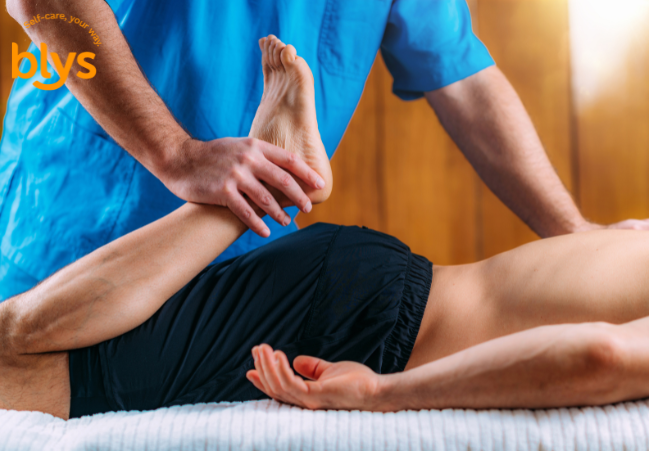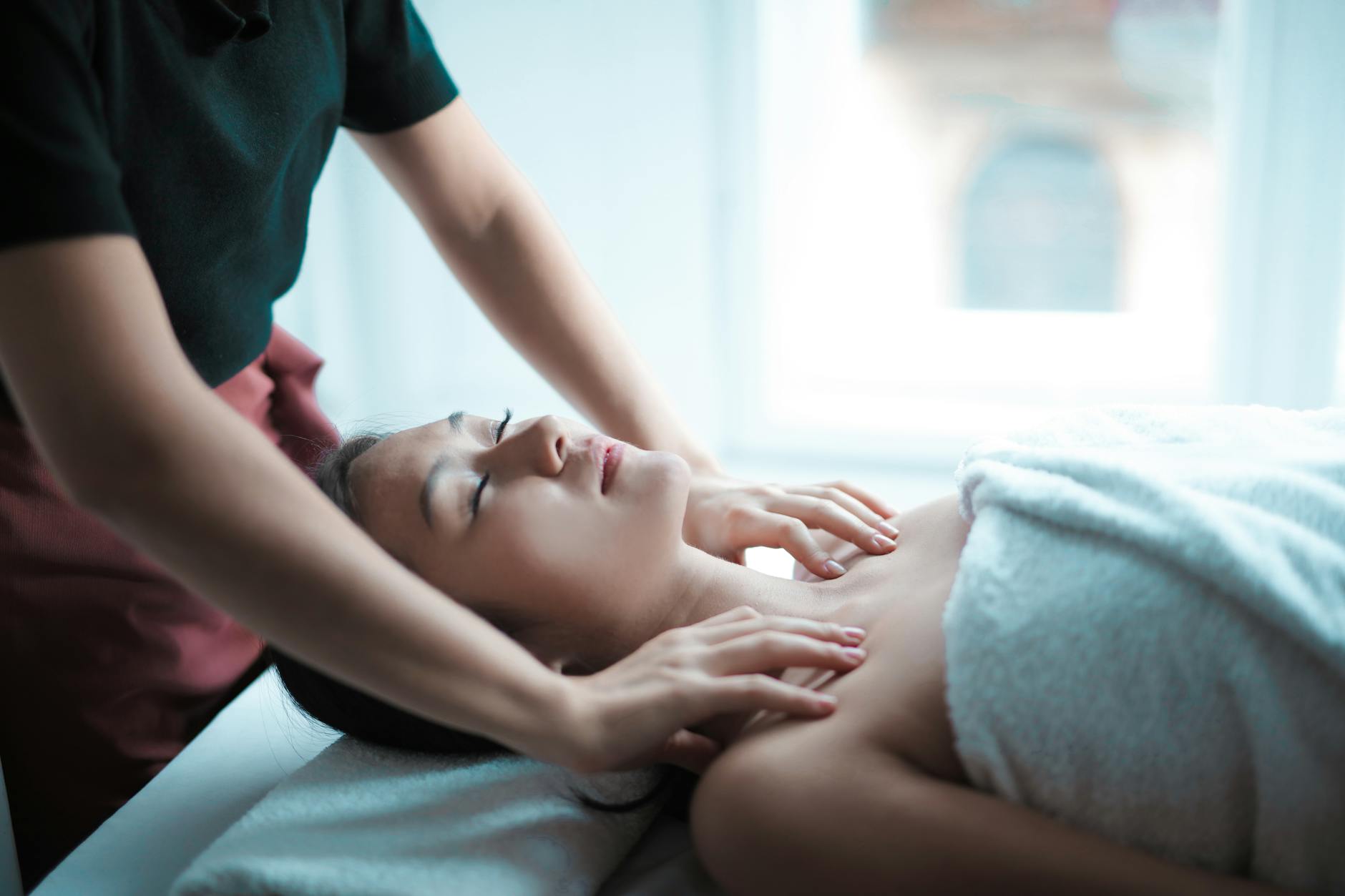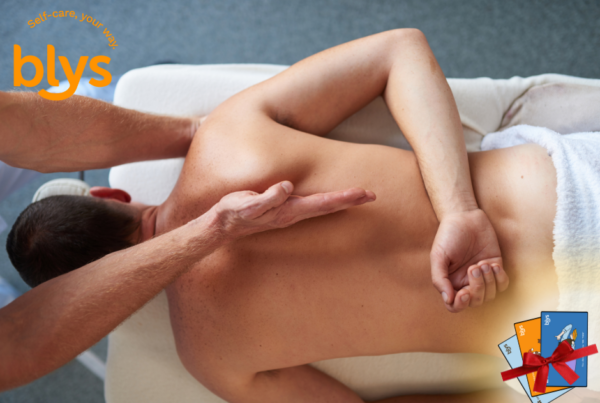
If you think sports massage is only for elite athletes or pro football players, think again. These days, it’s just as common for weekend runners, regular gymgoers, or even office workers with stiff shoulders to book a session. Whether you’re recovering from a tough workout or easing everyday muscle tension, sports massage can help you move better, feel lighter, and recover faster.
Unlike a relaxation massage, a sports massage focuses on the muscles you use most—helping reduce tightness, improve mobility, and support your overall well-being. And no, you don’t need to be training for a triathlon to see the benefits.
Even better, you don’t have to leave the house. With Blys, you can book a mobile sports massage and have a qualified therapist come to your home, hotel, or office. Whether you’re in Alabama, Hawaii, Nebraska, California, or beyond, expert care is just a few taps away.
What is sports massage?
Sports massage is a focused, practical form of massage therapy designed to help your body perform at its best. While relaxation or Swedish massage is mainly about easing stress, sports massage targets the muscles you rely on most, especially after exercise or during recovery.
It’s not just for elite athletes. Anyone who moves regularly, whether through gym sessions, running, cycling, or even physical work, can benefit from the structure and purpose behind this type of massage.
Here’s how it stands out from a typical massage:
- Focuses on function, not just relaxation: Aims to restore mobility, reduce soreness, and prevent injury.
- Targets specific muscle groups: Great for areas that are overworked, tight, or prone to strain.
- Uses a combination of techniques: May include deep tissue massage, trigger point therapy, stretching, and compression.
- Supports both prevention and recovery: Useful before a big event or after a tough workout.
Whether you’re training hard or simply feeling the impact of daily movement, sports massage offers a more tailored approach to help your body feel and perform better.
Learn more about sports massage and how it can support your routine.
Benefits Backed by Science
Sports massage isn’t just about feeling good, it delivers measurable benefits that have been backed by research. From easing sore muscles to improving mental clarity, here’s how sports massage can support your body and mind:
- Improves circulation and muscle function: Massage applies mechanical pressure that can increase muscle compliance and improve blood vessel responsiveness—potentially aiding nutrient delivery and waste removal from muscles, which supports performance and recovery.
- Reduces delayed onset muscle soreness (DOMS): Research shows sports massage can reduce DOMS by around 30% within 24–72 hours post-exercise. A systematic review confirms up to a 72-hour benefit, with relief lasting up to four days.
- Enhances flexibility and range of motion: Meta-analyses indicate massage improves flexibility alongside reducing soreness, making movement smoother and aiding performance over time.
- Supports stress relief and mental clarity: Massage helps downregulate stress hormones like cortisol while boosting endorphin levels, contributing to reduced stress, a calming effect, and clearer thinking.
Whether you’re working towards a fitness goal or just trying to feel your best, the benefits of sports massage go well beyond the physical.
Next, let’s explore what actually happens during a sports massage session, so you know exactly what to expect on the day.
What Happens During a Sports Massage Session
If it’s your first time booking a sports massage, knowing what to expect can help ease any nerves. While every therapist may have their own style, most sessions follow a fairly consistent flow designed to meet your unique needs.
Here’s a general breakdown of what usually happens:
- Initial chat: Your therapist will ask about your lifestyle, activity level, injuries, and any areas of concern. This helps them tailor the session to suit your goals—whether it’s recovery, mobility, or tension relief.
- Getting comfortable: You’ll be asked to lie on the massage table. You can undress to your comfort level, your therapist will use towels or draping to keep you covered and at ease throughout the session.
- Targeted techniques: Expect a mix of kneading, gliding strokes, compression, and assisted stretching. These techniques are designed to improve circulation, reduce stiffness, and release muscle tension.
- Focus areas: Depending on your needs, the therapist may concentrate on certain muscle groups like your hamstrings, calves, quads, shoulders, or back.
- Sensation: You might feel some discomfort in tight areas, but it shouldn’t feel unbearable. Speak up if the pressure is too much; your therapist will adjust accordingly.
Next up, we’ll answer one of the most common beginner questions: “Is sports massage painful?
Not sure how to choose the right therapist? Here’s how to find a qualified sports massage professional to make sure you’re in good hands from the start.
Is Sports Massage Painful? Let’s Clear It Up
A common concern among beginners is whether a sports massage will hurt. The short answer? It may feel intense, but it definitely shouldn’t be painful.
There’s a clear distinction between therapeutic discomfort (sometimes referred to as “good pain”) and sharp, unpleasant pain. Therapeutic discomfort happens when release occurs in tight muscles or trigger points—it feels like a deep stretch or pressure, but it’s not alarming. In fact, it’s a recognized sign that your muscles are responding to treatment.
Another factor to consider is pressure intensity. Evidence shows that moderate pressure massage is often more effective for reducing stress and improving well-being than light pressure. That means enduring extreme force isn’t necessary for good results.
With Blys, your therapist is trained to adapt their technique. If you feel any discomfort at all, you’re encouraged to speak up. Doing so ensures the session remains effective and comfortable, not painful. A good sports massage should leave you feeling limber and restored, not bruised or sore.
How to Prepare for a Sports Massage
A little preparation goes a long way when it comes to getting the most out of your sports massage. Whether you’re booking your first session or simply want a smoother experience, here are a few simple tips to keep in mind:
| What to Do | Why It Matters |
| Stay hydrated before and after | Water helps flush out toxins and keeps your muscles supple. |
| Avoid heavy meals beforehand | A light stomach makes it easier to lie comfortably during your session. |
| Have a quick shower if needed | Especially important for in-home massages to ensure hygiene and comfort. |
| Wear loose, comfy clothing | Easy to change in and out of, and better for post-massage recovery. |
| Expect some post-session soreness | It’s completely normal—your muscles are adjusting to the work done. |
Want more prep tips? You can also check out our guide to preparing for lymphatic drainage massage—many of the same basics apply.
Short on time? Mobile sports massage is a convenient option that fits around your busy schedule – no travel needed.
Aftercare Tips for Beginners
Your sports massage doesn’t end when the therapist packs up. What you do afterwards plays a key role in how well your body responds. Proper aftercare helps you recover faster, reduce soreness, and extend the benefits of your treatment.
Here’s how to support your body post-massage
1. Hydrate well
Massage stimulates blood flow and encourages the release of waste products from your muscles. Drinking plenty of water afterwards helps flush these out and keeps you feeling energized.
2. Move gently
Light activities like walking or stretching can keep your muscles from stiffening up. Avoid complete inactivity, but don’t push too hard either.
3. Skip intense workouts for the day
It’s best to avoid heavy gym sessions or strenuous cardio straight after your massage. Your muscles need time to heal and adjust.
4. Rest if needed
Mild soreness is completely normal, especially if the session involved deep pressure or trigger point work. Give your body a chance to recover.
5. Make it a habit
One massage is helpful, but regular sessions can make a real difference to your mobility, performance, and general well-being.
With Blys, it’s easy to schedule ongoing sessions or repeat bookings directly through the app, so your recovery routine can stay on track with zero fuss.
When to Book a Sports Massage (and How Often)
Timing your sports massage right can make all the difference in your recovery and performance. Whether you’re training hard or managing daily tension, knowing when to book in helps you stay ahead of fatigue and injury.
Sports massage is especially beneficial after:
- Intense workouts: Post-session treatment helps reduce muscle soreness and improve recovery.
- Long runs or training blocks: Helps flush out lactic acid, ease tightness, and restore mobility.
- Sports events or competitions: A massage after game day can support quicker bounce-back and prevent lingering pain.
But it’s not just for the tough days. Many people include sports massage in their regular wellness routine, scheduling sessions weekly or biweekly to maintain flexibility and reduce tension before it builds up.
It’s also important to listen to your body. If you’re feeling extra tight, sore, or fatigued, that’s often your cue to book a session even if it’s been a while.
Thanks to Blys’ mobile service, keeping consistent is simple. Whether you’re at home, in the office, or staying at a hotel, you can fit in recovery without rearranging your day.
Choosing the Right Sports Massage Therapist
Not all massage therapists are the same—and when it comes to sports massage, experience matters. Choosing the right practitioner can make a big difference in how effective and comfortable your session is.
Start by looking for someone who is licensed, insured, and trained specifically in sports or remedial massage. These therapists understand the demands physical activity places on the body and how to tailor techniques for recovery, performance, and injury prevention.
With Blys, you’re in safe hands. All therapists are fully vetted, qualified, and experienced in delivering sports massage. Whether you’re a casual runner or a seasoned athlete, you’ll be matched with a professional who understands your goals.
Before booking, you can view therapist profiles, ratings, and reviews through the Blys app or website. This allows you to choose someone who suits your needs, preferences, and location.
Need more reassurance? See the benefits of sports massage for athletes to understand why choosing the right therapist makes all the difference.
Relax, You’re in Good Hands With Blys
It’s completely normal to feel a little unsure before your first sports massage—but you’ll likely finish the session feeling lighter, looser, and more at ease.
Whether you’re active or just dealing with everyday tension, regular sports massage can help support better movement, recovery, and overall well-being.
And with Blys, there’s no need to travel. Enjoy expert care in the comfort of your own home.
Need relief that comes to you? Book a mobile sports massage with Blys and enjoy expert care without the hassle of travel.





